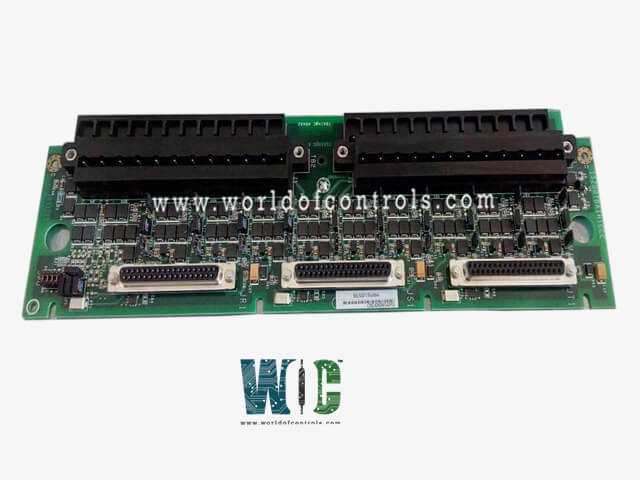SPECIFICATIONS
Part No.: IS200TBRIH1CDC
Manufacturer: General Electric
Country of Manufacture: United States of America (USA)
Size: 15.9 cm high x 10.2 cm wide
Temperature: -30 to +65oC
Technology: Surface mount
Product Type: Analog Module
Availability: In Stock
Series: Mark VIe
Functional Description
IS200TBRIH1CDC is an analog module developed by GE. It is part of the Mark VIe series. This module serves as an interface between field devices (sensors or transmitters) and the Mark VIe control system, allowing the system to receive analog signals from various sensors and process them for monitoring and control purposes.
Processor Features
- High-Speed Processor with Memory: The processor board integrates a high-speed processor equipped with Random Access Memory (RAM) and flash memory. This configuration enables swift processing of data and efficient storage of essential system information and operational parameters.
- Dual Independent Ethernet Ports: Featuring two fully independent 10/100 Ethernet ports with connectors, the processor board facilitates robust network connectivity. This dual-port setup allows for simultaneous and independent communication channels, enhancing data transmission reliability and flexibility.
- Hardware Watchdog Timer and Reset Circuit: To ensure system stability and reliability, the processor board incorporates a hardware watchdog timer and a reset circuit. These components play a crucial role in monitoring system operations and initiating necessary resets or actions in case of identified faults or irregularities.
- Local Ambient Temperature Sensor: An integrated local ambient temperature sensor enables the board to monitor and maintain awareness of environmental conditions. This information aids in optimizing system performance by adjusting operations based on temperature variations.
- Infrared Serial Communications Port: The inclusion of an infrared serial communications port offers an additional communication interface for specific applications or connectivity requirements, expanding the board's versatility in data exchange.
- Status-Indication LEDs: The board features status-indication LEDs that provide visual cues regarding system states and operational conditions. These LEDs offer quick visual feedback, aiding in diagnostics and monitoring of the board's status.
- Electronic ID and ID Reading Capability: The processor board possesses an electronic ID feature and the capability to read IDs on other interconnected boards. This functionality allows for board identification and verification, facilitating system configuration and diagnostics.
- Programmable Logic Support: The processor board incorporates substantial programmable logic capabilities. This feature supports and governs the functionality of the acquisition board, enabling versatile programming and control options tailored to specific system requirements.
- Power Connectors and Supplies: It includes an input power connector equipped with soft start and current limiting features for power management and system stability. Additionally, the board houses local power supplies responsible for sequencing and monitoring power distribution within the system.
Fiber-optic Cable
- Wavelength Specifications: Multimode fibers are designed to operate at two primary wavelengths: 850 nm and 1300 nm. These wavelengths are commonly used in short-range communication applications due to their compatibility with light sources such as light-emitting diodes (LEDs) and vertical-cavity surface-emitting lasers (VCSELs).
- Cable Attenuation: The attenuation, or loss of signal strength, in multimode fiber-optic cable typically ranges between 3.0 and 3.3 dB/km at 850 nm. This attenuation level is acceptable for short-distance transmissions within buildings, campuses, or local area networks (LANs).
- Core Diameter and Index of Refraction: The core of multimode fiber is typically 62.5 microns in diameter. Within the core, the index of refraction gradually changes from a higher value at the center to a medium value at the circumference. The higher index of refraction at the center slows down light rays, causing them to curve back towards the center as they travel through the fiber. This phenomenon is known as modal dispersion.
- Graded Index Design: The graded index of refraction in multimode fiber is designed to maintain nearly equal delays for light rays traveling through different paths within the fiber. This ensures that the shape of the light pulse is preserved as it propagates through the fiber. By slowing down the light rays near the core's circumference and allowing them to travel faster towards the center, the graded index helps minimize modal dispersion and improve overall signal integrity.
- Benefits and Applications: Multimode fiber-optic cable is well-suited for applications requiring high-speed data transmission over short distances, such as local area networks (LANs), data centers, and multimedia applications. Its relatively large core diameter and compatibility with cost-effective light sources make it a popular choice for short-range communication links where high bandwidth and reliability are essential.
The WOC team is always available to help you with your Mark VIe requirements. For more information, please contact WOC.
Frequently Asked Questions
What is IS200TBRIH1CDC?
It is an analog module developed by GE under the Mark VIe series.
What does the power-up self-test encompass?
During system initialization, a comprehensive self-test is conducted. This test includes checks on vital components such as RAM, flash memory, Ethernet ports, and various hardware components of the processor board. The purpose is to ensure these components are functional and operational.
How are internal power supplies monitored?
Continuous monitoring of the internal power supplies is conducted to verify their proper functioning. This ongoing monitoring is crucial for system stability and reliability.
